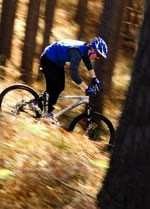 FRAME
FRAME
All Trek OCLV frames are made in-house and, while it’s common knowledge what the letters stand for, there are now different levels of OCLV. The 9.8 is made from OCLV 110, which means there’s 110g of carbon thread in a metre of the sheet Trek uses to make the frame. So for example OCLV 55 has 55g of thread and OCLV 120 has 120g.
The 9.8 frame design follows pretty conventional lines apart from the down tube, which has a teardrop profile. This is to create a wide enough anchor point for the aluminium shock mount, which is bonded in place. There’s space inside the main frame for a normal sized bottle cage and there’s line guides for a remote shock lockout.
For 2007 Trek uses new Hi-Lo (asymmetric) chainstays. They feature tapered tubes, forged pivot links and indents for heel clearance. Trek claims the whole rear assembly is 200g lighter than last year.
All Fuels now feature cartridge bearings but on the Top Fuels only the main pivot get bearings; Delrin bushings are still used in the Rocker Links. They’re lightweight but result in quite a bit of stiction in the system — we could feel it when we removed the shock.
Frame geometry is good — the 9.8 has a 12.75in bottom bracket height and slack (for a race bike) 69.5degree head angle. The top tube is between the Whyte and Rocky and overall it’s a good length.
SUSPENSION
Fox’s F100 X fork is similar to the F100 we tested last month but the X means a TerraLogic ‘Race Tune’ cartridge. Think of this as an automatic platform; low frequency stuff, like riding out of the saddle, won’t activate the fork but hit anything at speed and it opens like a regular Float.
Trek’s R1 tuned rear suspension system is just a single pivot with a couple of rocker links pumping the rear shock. The shock is a Manitou S-Type SRL with rebound adjustment and a lockout lever. Rear travel is 90mm.
COMPONENTS
Both jockey wheels on the SRAM XO rear derailleur seized solid after only a few wet rides, resulting in the chain jamming and bending the rear hanger. The external bearings in the Truvativ bottom bracket are also pitted and the main pivot bearings feel rough.
We fitted some SRAM Matchmakers (integral shifter/brake lever clamps) on this bike and when we removed the original X-9 clamps we found some cracks on the Bontrager Race X Lite carbon bar. Trek says this is purely cosmetic and shows up on the thick lacquer on the mid range X Lite bar.
To be on the safe side we swapped the bars for some pricier and wider USA-made Race XXX Lite risers.
PERFORMANCE
We spent four months testing this bike over the winter — it’s done the Salisbury Plain Challenge, a Gorrick and numerous trail rides. By the time it came to the photoshoot, we’d finished testing it — unfortunately that’s when the frame broke. Trek flew over Chad Manuell, its OCLV engineering manager, the very next day to talk to us. Manuell said the reason our frame broke is because Trek sent us a ‘late pre-production’ frame by mistake (see comments, left).
We feel our ride impressions are still relevant so we’ve included them here: stiction in the rocker links means the Top Fuel wasn’t very supple, even running more than the usual amount of sag for our weight. Lowering tyre pressure or even swapping to tubeless tyres (the wheels are UST ready) does improve the small bump ride but we feel the Top Fuel would be better with smoother bearings. The F100 X fork props the front end up and keeps rider weight well centred and as result the bike feels very predictable, even safe.
VERDICT
If the Top Fuel 9.8 had stayed in one piece we’d have given it an eight. It has good geometry, a balanced specification and you’re getting a carbon main frame for aluminium pricing. What drops the score two points is the excessive stiction, the handlebar and bottom bracket bearings. However, we have to base our rating on a bike with major faults — and a break is a major fault, meaning three out of ten. Of course we’ll reassess this rating when we get a full production frame and publish the result at a later date.
MBR RATING: PENDING



